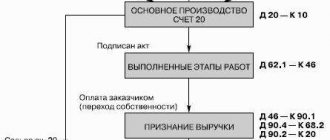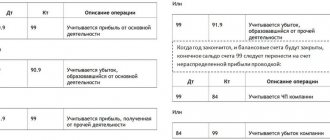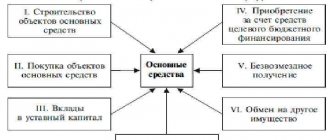Account 79 in accounting: On-farm calculations
Account 79 of accounting is an active-passive account “Intra-business settlements”, serves to summarize information on all types of settlements with separate divisions that are on a separate balance sheet of companies: branches, representative offices, departments and others, namely on:
- allocated property,
- mutual release of material assets;
- sale of goods, works and services;
- transfer of expenses of general management activities;
- remuneration of department employees, etc.
Account 79 in accounting
Scheme of movements in the debit and credit of account 79 “On-farm settlements”:
Subaccounts for account 79 are shown in the figure:
Analytical accounting for account 79 “Intra-business calculations” of accounting is carried out according to:
- each separate division of the enterprise on a separate balance sheet;
- each property trust management agreement.
Accounting entries with account 81
Typical transactions for account 81 include:
| Debit correspondence | Loan correspondence | the name of the operation |
| 81 | , , , | The shares were purchased from shareholders using funds from a cash account or cash register. Payment can be made in foreign currency |
| 81 | 91.1 | Income received from the sale of shares |
| 73 | 81 | Company employees bought back their own shares |
| 81 | Shares purchased from own shareholders were canceled | |
| 91.2 | 81 | Fixed expenses arising from the sale of shares |
The data from account 81 is reflected in the liability side of the balance sheet on line 1320. The information is closed in parentheses, since the account is active, but is reflected in the liability side of the balance sheet.
Postings to account 79 “Intra-business settlements”
Correspondence and main postings to the “Internal business settlements” account are presented in the table:
| Account Dt | Kt account | Wiring Description |
| 79 | 01/04/05/07/ Get 267 video lessons on 1C for free: 43/58, etc. | Transfer of property to a separate division (hereinafter referred to as the SB) and a trustee (from the parent organization and the founder of the management). Acceptance of property by the OP and the trustee – reverse posting. Return of property upon closure of the OP/termination of the trust management agreement (in the OP). The property is accounted for in the parent organization - reverse posting. |
| 79 | 02 | Accumulated depreciation on property received from the OP. Reflection of amounts - reverse posting. |
| 79 | 20/23/29 | Reflection of the provision of EP services |
| 79 | 25/26 | Write-off of part of management expenses for OP |
| 79 | 50/51/52/55 | Reflection of the transfer of funds to the OP |
| 79 | 60 | Acceptance of invoices from suppliers/contractors for assets, works/services for the OP. Repayment of debt at the expense of the OP - reverse posting. |
| 79 | 70 | Calculation of payments to employees of the OP. When an employee is transferred from an EP, arrears of wages are reflected. Transfer of debt - reverse posting. |
| 79 | 71 | Reflection of payment to accountable persons of the EP's debts When transferring an employee from the EP, re-registration of accountable amounts is a reverse entry. |
| 79 | 76 | Insurance of the property of the OP (accrual of payments) and charges to various organizations for services for the OP. Payment of debt at the expense of the OP - reverse posting. |
| 79 | 84 | Write-off of losses at the expense of the OP and the trustee. Accrual of income to employees of the OP - reverse posting. |
| 79 | 90/91 | Reflection of income from the activities of the OP. Reflection of OP expenses - reverse posting. |
| 79 | 99 | Reflection of losses from emergency circumstances at the expense of the OP. Disposal costs – reverse entry. |
| 05 | 79 | Reflection of the amount of accumulated depreciation on intangible assets. |
| 23/25/26/ 29/97 | 79 | Costs transferred by internal departments (according to advice notes) are taken into account. |
Postings to account 81: withdrawal of shares from circulation
In this case, the following business transactions are registered on the JSC side:
- Payment of the value of shares that are purchased from third parties, their acceptance onto the balance sheet: Dt 81 Kt 51.
The amount corresponds to the actual price of shares on the market.
- Withdrawal of shares from circulation, accompanied by a decrease in the amount of the authorized capital: Dt 80 Kt 81.
Here the amount is already the nominal price of the shares established at the time of issue.
- Writing off the negative balance on account 81 (assuming that the actual price is greater than the nominal price, this is the usual scenario) as expenses: Dt 91 Kt 81.
And if the price is lower than the nominal price, then the sequence of transactions is different:
- Dt 80 Kt 81 (amount - market price of shares);
- Dt 80 Kt 84 (difference between nominal and market price).
This “concept” follows from the fact that the rules of PBU 9/99, strictly speaking, do not provide for the generation of income through the redistribution of already paid authorized capital (in this case, in the amount corresponding to the difference between the market and nominal price of shares). Therefore, we attribute the difference to retained earnings.
How is account 79 used in accounting?
Account 79 performs the function of a registrar of all business transactions between the head office and branches of the enterprise. Transactions related to interaction with departments are reflected on a separate balance sheet.
Such mutual settlements can be based on:
- Transfer of property (equipment, materials and other assets) to the subdivision fund.
- Payroll calculations for branch employees in cases where the payroll is located in the central office.
- Deductions related to asset trust management agreements.
- Mutual settlements for current operations (all settlements related to the activities of the organization: sales, rent, provision of services, etc.).
A trust agreement is a transfer of assets (profit-generating property) to a department (branch, division) for the purpose of managing these assets to obtain benefits to the party transferring the property assets.
Account 79 - active-passive. It records the operations of both the company's head office and the receiving party - the divisions. The debit reflects the actions of the transferor, and the credit - the receiver (this approach is valid for the transfer of assets, with liabilities - the opposite is true).
Subaccounts and analytics
For the convenience of systematizing information, the following sub-accounts can be opened for account 79:
- 79.01 “On allocated property”;
- 79.02 “For current operations.”;
- 79.03 “Under a property trust management agreement.”
Account 79 reflects the mutual settlements of the organization with its branches, divisions, subsidiaries, etc. Analytical accounting is carried out separately for each division/agreement, which implies the opening of additional sub-accounts, the number and nature of which are determined by the specifics of the company’s accounting policy.
Account 81 “Own shares (shares)”
This material, which continues the series of publications devoted to the new chart of accounts, analyzes account 81 “Own shares (shares)” of the new chart of accounts. This commentary was prepared by Y.V. Sokolov, Doctor of Economics, Deputy. Chairman of the Interdepartmental Commission on Reforming Accounting and Reporting, member of the Methodological Council on Accounting under the Ministry of Finance of Russia, first President of the Institute of Professional Accountants of Russia, V.V. Patrov, professor of St. Petersburg State University and N.N. Karzaeva, Ph.D., deputy. Director of the audit service of Balt-Audit-Expert LLC.
Account 81 “Own shares (shares)” is intended to summarize information on the availability and movement of own shares purchased by the joint-stock company from shareholders for their subsequent resale or cancellation. Other business companies and partnerships use this account to account for the share of a participant acquired by the company or partnership itself for transfer to other participants or third parties.
When a joint-stock or other company (partnership) buys from a shareholder (participant) shares (shares) belonging to him, an entry is made in the accounting records for the amount of actual costs in the debit of account 81 “Own shares (shares)” and the credit of cash accounting accounts.
Cancellation of own shares purchased by a joint-stock company is carried out on the credit of account 81 “Own shares (shares)” and the debit of account 80 “Authorized capital” after this company has completed all the prescribed procedures. The difference arising in account 81 “Own shares (shares)” between the actual costs of repurchasing shares (shares) and their nominal value is charged to account 91 “Other income and expenses”.
In practice, situations often arise when organizations, for one reason or another, buy back their own shares (shares in the authorized (share) capital) from shareholders (participants). In particular, joint-stock companies can do this (subject to the procedures and restrictions established by law) to temporarily reduce the number of shares in circulation in order to increase their prices, counter attempts by other organizations to buy up part of the voting shares of the company, change the balance of power at the general meeting of shareholders (repurchased shares are not taken into account when voting on a particular issue), to reduce the authorized capital by canceling repurchased shares, etc.
In cases established by law, joint stock companies must buy back their own shares at the request of shareholders.
For example, in Art. 75 of the Federal Law of December 26, 1995 No. 208-FZ “On Joint-Stock Companies” lists cases when shareholders-owners of voting shares have the right to demand the company buy back all or part of their shares:
a) when making amendments and additions to the company’s charter or approving a new version of the company’s charter, limiting the rights of shareholders; b) during a reorganization of the company or a major transaction, if in both of these cases the shareholders voted against the adoption of these decisions or did not take part in the voting.
Federal Law No. 208-FZ of December 26, 1995 “On Joint Stock Companies” also established restrictions on the repurchase of its own shares by the company. It is not possible to purchase outstanding shares:
- until full payment of the entire authorized capital of the company;
- if at the time of their acquisition the company meets the signs of insolvency (bankruptcy) in accordance with the legal acts of the Russian Federation on the insolvency (bankruptcy) of enterprises or these signs appear as a result of the acquisition of these shares;
- if at the time of their acquisition the value of the company's net assets is less than its authorized capital, reserve fund and the excess over the par value of the liquidation value of the placed preferred shares determined by the charter or becomes less than their size as a result of the acquisition of shares - for ordinary shares;
- if at the time of their acquisition the value of the company's net assets is less than its authorized capital, reserve fund and the excess over the par value of the liquidation value of the placed preferred shares, determined by the charter, the owners of which have priority in the order of payment of the liquidation value over the owners of the types of preferred shares to be acquired, or becomes less their size as a result of the acquisition of shares - for preferred shares;
- until the redemption of all shares, the redemption requirements for which were presented in accordance with Article 76 of Federal Law No. 208-FZ of December 26, 1995.
Limited liability companies (LLC), in cases provided for by Federal Law No. 14-FZ dated 02/08/1998 “On Limited Liability Companies”, can also acquire shares (parts of shares) in their authorized capital.
The joint stock company repurchases its own shares at their market value, which, as a rule, does not coincide with the par value.
Clause 3.6 of the procedure for recording transactions with securities in accounting, approved by Order of the Ministry of Finance of Russia dated January 15, 1997 No. 2, prescribed that own shares purchased from shareholders be accounted for in the “Money Documents” account at par. The difference between the redemption price and the par value should have been reflected in the credit of the Profit and Loss account (if the redemption price was below par) or in the accounts of own sources (if the redemption price was higher than par). As a result, in the first case, a profit arose, on which tax was immediately levied. If the repurchased shares are cancelled, real income will only arise after cancellation. If these shares are resold, then the income will actually be the difference between the sale and repurchase prices. It is quite possible that a loss will arise from the sale of these shares (if sold at a price lower than the redemption price).
Based on this, the Supreme Court of the Russian Federation, by decision dated December 1, 1998 No. GKPI 98-525, invalidated the above paragraph 3.6 of Order No. 2 of the Ministry of Finance of Russia dated January 15, 1997. Consequently, own shares purchased from shareholders must be accounted for by joint-stock companies in account 81 “Own shares (shares)” based on the amount of actual costs. In the same way, this account should account for the shares of participants acquired by business companies and partnerships for transfer to other participants or third parties.
Example of invoice registration 79
(St. Petersburg), decided to open a branch in Vologda, using calculations on a separate balance sheet. The company transferred equipment worth RUB 300,000 to the branch for use. (with depreciation equal to 81,000 rubles) and procurement materials totaling 52,000 rubles. As a result, the accountant generated the following entries:
- from the debit of account 79 to the credit of account 01, he wrote off the amount of 300,000 rubles, reflecting the transfer of equipment to the branch;
- from the debit of account 02 to the credit of account 79, he wrote off the amount of 81,000 rubles, reflecting depreciation;
- from the debit of account 79 to the credit of account 10, he wrote off the amount of 52,000 rubles, reflecting the transfer of procurement materials.
On the part of the Vologda branch of Fix LLC, transactions will be registered in the reverse order.
Examples of transactions and postings on account 79
Let’s assume that JSC Fonet, Moscow, opened its branch in Samara on a separate balance sheet and transferred to it:
- technological equipment - 130,000 rubles, depreciation - 35,000 rubles;
- batch of materials - 25,000 rubles.
The transfer of property to a separate division in Samara is reflected by the following entries in account 79:
| Account Dt | Kt account | Transaction amount, rub. | Wiring Description | A document base |
| Moscow | ||||
| 79.01 | 01 | 130 000 | Equipment written off (initial cost) for the branch | Interbranch advice note |
| 02 | 79.01 | 35 000 | The amount of depreciation on it is written off | Interbranch advice note |
| 79.01 | 10 | 25 000 | Written off materials (cost) | Interbranch advice note |
| Samara | ||||
| 01 | 79.01 | 130 000 | Capitalization of equipment | Interbranch advice note |
| 79.01 | 02 | 35 000 | Depreciation has been taken into account | Interbranch advice note |
| 10 | 79.01 | 25 000 | Materials have been capitalized | Interbranch advice note |
- Account 75 in accounting: entries for settlements with founders
- Accounting account 60: postings, examples, subaccounts
- Postings for returning goods from the buyer
- Account 73 in accounting: postings, examples, subaccounts
Account 79 - On-farm settlements
Account type: Active-passive Current
On-farm settlements are intended to summarize information on all types of settlements with branches, representative offices, divisions and other separate divisions of the organization, allocated to separate balance sheets (intra-balance sheet settlements), in particular, settlements on allocated property, on the mutual release of material assets, on the sale of products, works , services for the transfer of expenses for general management activities, for remuneration of department employees, etc.
The property transferred to trust management is written off by the founder of the management from accounts 01 “Fixed Assets”, 04 “Intangible Assets”, 58 “Financial Investments”, etc. to the debit of account 79 “Intra-business settlements” (at the same time, a debit entry is made for the amount of accrued depreciation accounts 02 “Depreciation of fixed assets”, 05 “Depreciation of intangible assets” and the credit of account 79 “Intra-business settlements”). The property accepted by the trustee on a separate balance sheet is reflected in the debit of accounts 01 “Fixed assets”, 04 “Intangible assets”, 58 “Financial investments”, etc. and the credit of account 79 “Intra-business settlements” (at the same time, an entry is made for the amount of accrued depreciation on the credit of the accounts 02 “Depreciation of fixed assets”, 05 “Depreciation of intangible assets” and credit account 79 “Intra-business settlements”).
When the property trust management agreement is terminated and the property is returned to the management founder, reverse entries are made. If the property trust management agreement provides for other operations with the property transferred to trust management, then accounting for these operations is carried out in accordance with the general procedure.
The transfer of funds on account of the profit (income) due to the founder of the management in a separate balance sheet is reflected in the credit of cash accounting accounts and the debit of account 79 “On-farm settlements”. The funds received by the founder of the management on account of this profit (income) are credited to the debit of cash accounts in correspondence with account 79 “On-farm settlements”.
The amounts due from the trustee for compensation for losses caused by loss or damage to property transferred to trust management, as well as lost profits, are reflected in the debit of account 76 “Settlements with various debtors and creditors” in correspondence with the credit of account 91 “Other income and expenses” . When the founder receives control of these funds, cash accounting accounts are debited and account 76 “Settlements with various debtors and creditors” is credited.
Analytical accounting for account 79 “Intra-business settlements” is carried out for each branch, representative office, division or other separate division of the organization, allocated to a separate balance sheet, and settlements under property trust management agreements are carried out for each agreement.
Essence and meaning of position 79
79 account is necessary to consolidate data on settlements of the head office of a company with its structural divisions, subsidiaries or representative offices, the property of which has been transferred to separate accounting and which act as an independent legal entity.
The following subitems can be opened for the specified account:
- 1 – where transactions on the allocated property are reflected;
- 2 – where daily transactions are recorded;
- 3 – where information on transactions within the framework of a property trust agreement is shown.
According to subposition 79.1, the accounting service keeps records of working and non-current resources transferred, for example, to departments of an enterprise. When separating property, subaccount 79.1 is debited in correspondence with 01 and other positions.
In subposition 79.2, the accounting department of the head office reflects information on all other settlements with the designated divisions.
Subaccount 79.3 shows data on settlements with trust managers with property or rights, as well as on property that is accounted for on a separate balance sheet and transferred to trust management.
Property that has been transferred to trust management is debited to account 79 in correspondence with 01, 04, 58, 79 and other items. If the trust management agreement is terminated and the property is returned to the founder, then reverse accounting entries are introduced.
Position 79 is unique, since all other positions in the Chart of Accounts can correspond with it.
Analytics for position 79 is carried out in the context of each subsidiary, representative office or branch. If we are talking about trust management of property, then in this case the analysis is carried out for each such agreement separately.
Account 79: its use
Account 79 consolidates information on settlements of the parent organization with its own structural units, which are allocated to a separate balance sheet.
Analytical accounting for account 79 is organized in the context of the types of operations performed. As a rule, subaccounts are opened on the account to reflect settlements with property that was transferred in favor of a representative office or branch, or received from it. The account is also used to carry out settlements with the manager under a property trust management agreement.
| ★ Best-selling book “Accounting from scratch” for dummies (understand how to do accounting in 72 hours) > 8,000 books purchased |
When transferring property (writing off the balance sheet), its value is carried out according to Dt 79:
| Debit | Credit | Operation description |
| 79 | 21 | Semi-finished products were transferred to the branch |
| 79 | 50 | Cash issued in favor of the representative office |
| 79 | 29 | The cost of work performed by the service department was taken into account in favor of the branch |
When receiving property or funds, use Kt 79:
| Debit | Credit | Operation description |
| 52 | 79 | Funds were received from the representative office in foreign currency |
| 08 | 79 | The cost of investments in non-current assets was accepted from the branch |
| 11 | 79 | Fattening animals accepted from representative offices |
Accounts with which account 81 corresponds
This account is active. When an organization (company, partnership) repurchases its shares (shares) from a participant, they are reflected in the Dt account.
Cancellation of repurchased shares is reflected in the CT account, in correspondence with the authorized capital account.
Acceptance of shares for registration
Selena PJSC bought back 10 shares from shareholders at 950 rubles per share. The par value of the share is 1000 rubles.
| Dt | CT | Description of operations | Sum | Document |
| 81 | 75 | Capitalized property stock | 9500 | Accounting information |
| 75 | Paid for the purchase of shares | 9500 | Payment order ref. |
If payment for shares occurs within a month or quarter after submitting the application, you can get by with one transaction:
| Dt | CT | Operation description | Sum | Document |
| 81 | Share repurchase reflected | 9500 | Payment order ref. |
If the participant is an individual, personal income tax must be calculated:
| Dt | CT | Description of operations | Sum | Document |
| 75 | 68 | The amount of personal income tax has been accrued (9500*13%) | 1235 | Accounting information |
In this case, the transfer amount will look like this:
| Dt | CT | Operation description | Sum | Document |
| 75 | Transfer for shares (9500 - 1235) | 8265 | Payment order ref. | |
| 68 | Transfer of personal income tax | 1235 | Payment order ref. |
An organization may have several reasons for repurchasing its own shares:
- calculation to provide more favorable conditions on the market;
- desire to increase earnings per share;
- preventing a hostile takeover attempt;
- obtaining at your own disposal additional shares for your own activities, etc.
The purchase of own shares is not considered an acquisition of an asset. In effect, this transaction reduces assets.
Purchased shares are not included in the calculation of book value because they are not outstanding.
Sale of shares
After repurchasing the shares, the board of directors of Selena PJSC decided to sell 8 shares at 1,100 rubles per share.
| Dt | CT | Operation description | Sum | Document |
| 62(76) | 91.1 | Reflection of the sale price of shares (1100*8) | 8800 | Act, accounting certificate |
| 91.2 | 81 | Write-off of the book value of shares (950*8) | 7600 | Buh. reference |
| 62(76) | The receipt of DS from the sale of shares is reflected | 8800 | Bank statement | |
| 91.9 | 99 | Financial result reflected (8800 - 7600) | 1200 | Buh. reference |
In the case of the sale (transfer) of shares to another participant within the organization, these transactions will only affect the analytics of account 81, but not the overall result.
Reduction of the authorized capital due to repurchased shares
PJSC "Berezovaya Roshcha" bought back 500 shares at a price of 20 rubles per share, the cost of shares at par is rubles.
Since the shares were sold to a third party, the board of founders decided to reduce the authorized capital by this amount.
| Dt | CT | Description of operations | Sum | Document |
| 80 | 81 | Reduction of authorized capital (500*25) | 12500 | Accounting information |
| 81 | 91.1 | Reflection of the difference between the purchase price and the denomination (25*500 - 20*500) | 2500 | Accounting information |
The amount in excess of the nominal value over the purchase price (2,500 rubles) is reflected in the income account and is taken into account as part of non-operating income when calculating income tax.
Typical transactions on account 79 using examples
For a detailed examination of the features of accounting for on-farm settlements, we use examples of basic operations.
Account 79. Transfer of property in favor of a branch
The trading concern “Slavyanochka”, which operates in the field of production of bakery products, opened a branch “Ural” in Yekaterinburg. In April 2020, the main office of Slavyanochka transferred the following assets to the Ural branch:
- a batch of flour, the book value of which is 23,740 rubles;
- baking equipment (book value RUB 113,400, depreciation accrued RUB 38,600).
The accountant of “Slavyanochka” reflected this transfer as follows:
| Debit | Credit | Operation description | Sum | A document base |
| 79.1 | 01 | The transfer of baking equipment to the Uralsky branch is reflected (book value) | 113.400 rub. | Transfer and Acceptance Certificate |
| 02 | 79.1 | The depreciation accrued on the baking equipment transferred to the Uralsky branch was written off | RUB 38,600 | Transfer and Acceptance Certificate |
| 79.1 | 10 | The book value of flour transferred to the benefit of the Uralsky branch was taken into account | RUR 23,740 | Transfer and Acceptance Certificate |
The accountant carried out the same operation in the accounting of the Uralsky branch as follows:
| Debit | Credit | Operation description | Sum | A document base |
| 01 | 79.1 | The received baking equipment is reflected (book value) | 113.400 rub. | Transfer and Acceptance Certificate |
| 79.1 | 02 | Depreciation accrued on baking equipment received from Slavyanochka is reflected | RUB 38,600 | Transfer and Acceptance Certificate |
| 10 | 79.1 | The warehouse of the Uralsky branch received a batch of flour received from Slavyanochka | RUR 23,740 | Transfer and Acceptance Certificate |
| ★ Best-selling book “Accounting from scratch” for dummies (understand how to do accounting in 72 hours) > 8,000 books purchased |
Account 79. Settlements with the property manager
OA “Leader” is engaged in retail trade of household appliances. Sales of equipment are carried out through our own sales network. The stores are located in premises that are the property of JSC Leader.
Due to a significant decrease in sales volumes, “Leader” closed some of its retail outlets in March 2020. In order to compensate for the costs of maintaining its own premises in which the stores were located, Leader entered into a property trust management agreement with Nadezhny LLC. According to the agreement, “Reliable” leases the property, while transferring monthly profit in the amount of 14,400 rubles to “Leader”. 3 premises were transferred to the management of “Nadezhny”:
- book value of the premises – 1,347,900 rubles;
- accrued depreciation on premises - 513,800 rubles.
The fact of transfer of premises to management and receipt of profits under the contract is reflected by “Leader” in the following entries:
| Debit | Credit | Operation description | Sum | A document base |
| 79.3 | 01 | The transfer of premises to the management of Nadezhny LLC was taken into account (book value) | 1,347,900 rub. | Transfer and Acceptance Certificate |
| 02 | 79.3 | The amount of depreciation accrued on the cost of the premises transferred to the management of “Reliable” is reflected. | RUR 513,800 | Transfer and Acceptance Certificate |
| 79.3 | 91.1 | The amount of monthly profit from the transfer of premises to the management of “Nadezhny” is taken into account | 14,400 rub. | Transfer and Acceptance Certificate, Manager's Report |
| 51 | 79.3 | Funds from “Reliable” were credited as monthly profit under the trust management agreement | 14,400 rub. | Bank statement |
These transactions in the accounting of “Reliable” look like this:
| Debit | Credit | Operation description | Sum | A document base |
| 01 | 79.3 | The book value of premises received for management from “Leader” is taken into account | 1,347,900 rub. | Transfer and Acceptance Certificate |
| 79.3 | 02 | The amount of depreciation accrued on the cost of premises received for management from “Leader” is reflected. | RUR 513,800 | Transfer and Acceptance Certificate |
| 84 | 79.3 | The amount of monthly profit due to the “Leader” is taken into account | 14,400 rub. | Transfer and Acceptance Certificate, Manager's Report |
| 79.3 | 51 | Funds were transferred to “Leader” as monthly profit under a trust management agreement | 14,400 rub. | Payment order |
Accounting for intra-farm settlements
Intra-economic settlements are those carried out within an organization that has its own network of divisions and branches with a separate balance sheet, but is not a separate legal entity.
Accounting for on-farm settlements is carried out on account 79, which combines information on settlements, for example, on the mutual release and acceptance of goods and materials, sales of products, transfer of general management costs, salaries of department personnel, etc.
Let us recall what rules such operations are subject to.
Count 79: how to apply
Account 79 accumulates information about the calculations of the central structure with its subordinate separate divisions, allowing you to control intra-company processes. Chemical management involves maintaining analytical accounting for the types of operations carried out by each division with a separate balance sheet, and in a situation with the validity of trust management agreements (MA) - for each such agreement.
Depending on the specifics of the account. 79 open sub-accounts, the list of which the company records in its accounting policies. Their number is not limited by law, but it is more convenient to form operations according to a generally accepted scheme on sub-accounts:
- 79/1 “Settlements for allocated property”;
- 79/2 “Calculations for current operations”;
- 79/3 “Settlements under remote control agreements.”
When transferring property, costs or obligations, their value is shown as a debit to account 79, and when receiving – as a credit.
For example:
| Operations | D/t | K/t |
| The parent organization transfers to the branch: | ||
| OS with accrued wear and tear | 7902 | 0179 |
| Inventory | 79 | 10, 41 |
| Financing to current account | 79 | 51 |
| Expenses | 79 | 20, 23, 25, 26, 29 |
| Liabilities | 79 | 60, 76 |
| The branch receives from the parent organization: | ||
| OS | 0179 | 7902 |
| Inventory | 10,41 | 79 |
| Cash | 51 | 79 |
| Expenses | 20, 23, 25, 26, 29 | 79 |
| Liabilities | 60, 76 | 79 |
The transfer of costs from one company structure to another is formalized using approved forms of internal documents - advice notes. Internal operations are carried out not only between the central and subordinate structures, but also through the interaction of separate units with each other.
On the account
79, the state of internal settlements is taken into account, and the transactions are displayed in mirror images, mutually excluding each other, and therefore, in the general balance sheet of the company there are no changes associated with water chemistry - assets and liabilities are listed on the same accounts, only according to analytics they relate to different branches. Thus, when forming a consolidated balance sheet for the company, the account. 79 must be reset to zero: the debit balance at the branch must correspond to the credit balance at the head office, and vice versa. Let's look at examples of the practical use of account 79.
Example 1: Transfer of assets to a division
A trading company specializing in the sale of textile products opens a branch and transfers assets to it:
- a consignment of goods worth 300,000 rubles;
- warehouse space with a book value of RUB 200,000. with accrued depreciation RUB 56,000.
| Operations | D/t | K/t | Sum |
| In TC LLC "Len": | |||
| Goods transferred | 79/1 | 41 | 300 000 |
| Transfer of premises reflected | 79/1 | 01 | 200 000 |
| The amount of depreciation taken into account | 02 | 79/1 | 56 000 |
| At the branch: | |||
| The premises have been registered | 01 | 79/1 | 200 000 |
| Accrued depreciation taken into account | 79/1 | 02 | 56 000 |
| Goods received | 41 | 79/1 | 300 000 |
Example 2: settlements for mutual repayment of obligations
The Len LLC branch purchased a batch of goods from a third party in the amount of 600,000 rubles. The Len LLC branch does not have enough own funds and with a request to make payment with a guarantee of subsequent debt coverage, the branch turned to the head office of Len LLC.
Len LLC settled with Mir LLC by paying 600,000 rubles. To repay the debt, the Len LLC branch paid an invoice for the supply of goods for the head office of Len LLC in the amount of 200,000 rubles. supplier company Atlas LLC. Subsequently, the remaining debt to the head office in the amount of 400,000 rubles. the branch repaid by transfer from the current account. How will intra-economic calculations – postings – be reflected:
| Operations | D/t | K/t | Sum |
| At the Len LLC branch: | |||
| Repayment of debt to Mir LLC is reflected | 60 | 79/1 | 600 000 |
| Payment was made to Atlas LLC for the debt to the head office | 79/1 | 51 | 200 000 |
| The debt to the head office was repaid | 79/1 | 51 | 400 000 |
| At the head office of Len LLC: | |||
| Payment of delivery invoice for the branch | 79/1 | 51 | 600 000 |
| Repayment of debt to Atlas LLC is reflected | 60 | 79/1 | 200 000 |
| Funds have been received into the current account from the branch | 51 | 79/1 | 400 000 |
Example 3:
LLC "Len" closed the outlet, transferring, under an agreement, into trust management of LLC "Record" the store premises, which is the property of LLC "Len". According to the agreement, Record LLC leases the premises, transferring 20,000 rubles to the owner monthly. The cost of the premises on the balance sheet is 1,420,000 rubles, accrued depreciation is 360,000 rubles. Postings for water chemistry:
| Operations | D/t | K/t | Sum |
| At Len LLC: | |||
| The transfer of the premises to Record LLC with accrued depreciation is reflected | 79/302 | 0179/3 | 1 420 000360 000 |
| The amount of monthly income from the transfer is taken into account | 79/3 | 91/1 | 20 000 |
| Receipt of income under a remote control agreement | 51 | 79/3 | 20 000 |
| At Record LLC: | |||
| The book value of the premises transferred to the remote control and accrued depreciation are taken into account | 0179/3 | 79/302 | 1 420 000360 000 |
| The amount of profit due to Len LLC monthly under the management agreement | 99 | 79/3 | 20 000 |
| Transfer of due income | 79/3 | 51 | 20 000 |
The return of property from the remote control is processed through reverse postings.
Source: https://spmag.ru/articles/uchet-vnutrihozyaystvennyh-raschetov











